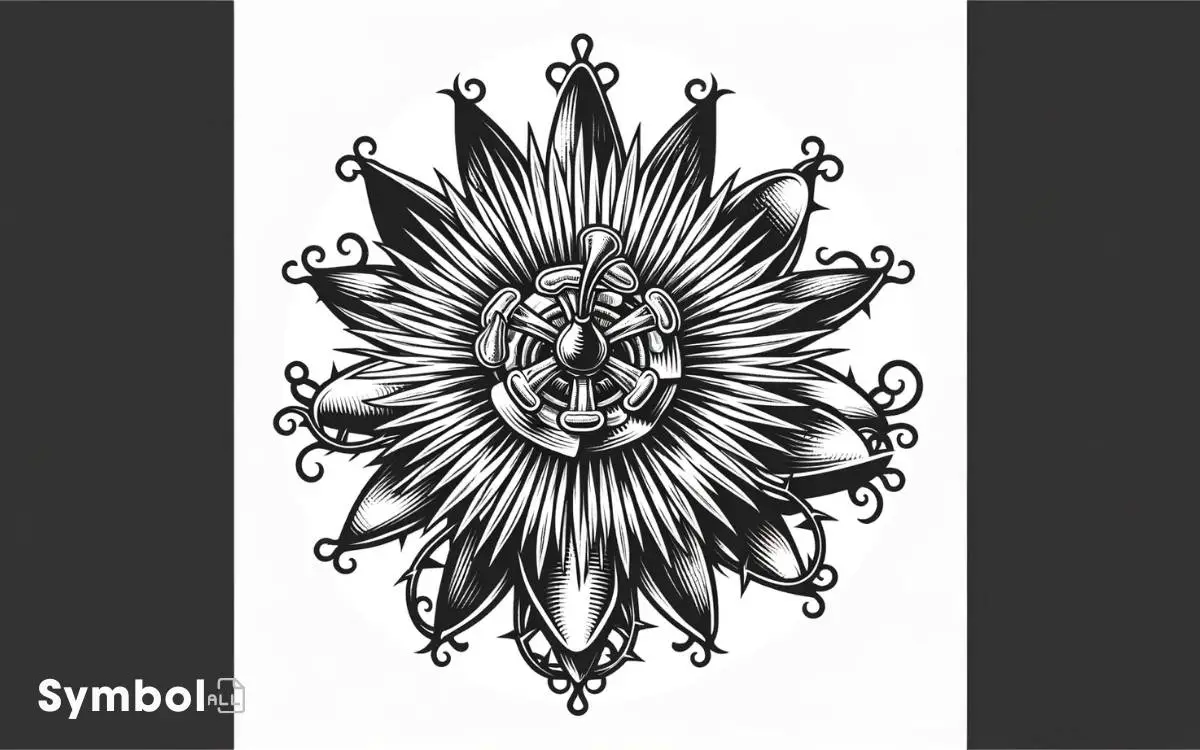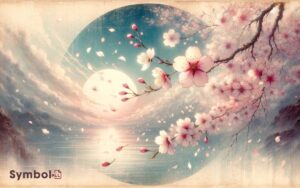Symbolism of the Passion Flower: Crown Of Thorns!
When you gaze at a passion flower, you’re witnessing a symbol that’s evolved over centuries. Initially, Spanish explorers marveled at its intricate structure, leading to deep Christian symbolism.
Its parts reflect the Passion of Christ: the apostles, crown of thorns, and wounds, forming a vivid floral testimony.
Beyond its spiritual significance, the flower conveys meanings of peace, friendship, resilience, and spiritual enlightenment across various cultures.
Recently, it’s come to symbolize environmental sustainability and mental well-being. Each layer of its symbolism offers insights into human and natural interconnectedness, promising a deeper appreciation of its beauty and significance.

Key Takeaways
Historical Origins
The historical origins of the passion flower can be traced back to the early 16th century, when Spanish explorers in South America first encountered its enchanting blooms and imbued them with religious significance.
These explorers documented the flower’s unique structure, noting its complex array of petals, filaments, and anthers, which they hadn’t observed in any other species.
This initial fascination led to detailed botanical studies to understand its reproductive mechanisms and categorize its various species.
Your understanding of the passion flower’s significance is enriched by recognizing that its discovery wasn’t merely by chance but a result of rigorous exploration and scientific curiosity.
This flower’s journey from a newfound species to a subject of scientific interest highlights the intersection of natural wonder and human inquiry, laying the groundwork for its symbolic interpretations.
Christian Symbolism
Upon its discovery by Spanish explorers, passion flower quickly became enveloped in Christian symbolism, with each part of its intricate structure being associated with a different aspect of the Passion of Christ.
The ten petals and sepals are believed to represent the ten faithful apostles, excluding Judas Iscariot for his betrayal and Peter for his denial. The corona of filaments displays the crown of thorns Christ wore during his crucifixion.
Additionally, the five stamens are seen as symbols of the wounds Jesus suffered, while the three stigma are interpreted as the nails used in his crucifixion.
The vine’s tendrils resemble the whips used in his flagellation, and the leaves’ shape is reminiscent of the spear that pierced his side.
This detailed symbology demonstrates the passion flower’s significance in Christian iconography, providing a floral testimony to the Passion narrative.
Cultural Meanings
Beyond its Christian symbolism, passion flower holds diverse meanings across various cultures, reflecting a rich tapestry of interpretations influenced by its unique morphology and history.
In some South American traditions, it’s seen as a symbol of peace and friendship, its intricate tendrils and vibrant blooms representing the complexity and beauty of relationships.
Among Native American tribes, the passion flower’s ability to thrive in varied environments symbolizes adaptability and resilience, echoing the communities’ values of harmony with nature and endurance through challenges.
In Eastern cultures, its meditative pattern is often associated with spiritual enlightenment and inner peace, highlighting the flower’s capacity to transcend its ornamental value and embody deeper, universal themes of human experience.
Each cultural interpretation enriches your understanding of this multifaceted flower, inviting a deeper appreciation beyond its visual allure.
Modern Interpretations
In today’s rapidly evolving society, passion flower symbolism has expanded to include a plethora of modern interpretations, reflecting contemporary values and concerns.
- Environmental Awareness: You now often associate the passion flower with ecological conservation efforts. Its resilience and adaptability symbolize the urgent need for environmental sustainability and biodiversity protection.
- Mental Health Advocacy: The calming effects of passion flower extracts on the nervous system have led to its representation of mental health awareness. It’s a botanical emblem for the importance of mental well-being and the destigmatization of mental health disorders.
- Global Unity: Given its wide distribution and cultural significance across continents, the passion flower embodies global unity and the celebration of cultural diversity. It’s a reminder that beauty and harmony can thrive amidst diversity.
Gardening and Care
To successfully cultivate passion flowers, you must understand their specific environmental needs, including ample sunlight, well-drained soil, and regular watering.
These climbers thrive in a habitat that mimics their native conditions, requiring at least six hours of direct sunlight daily to flourish.
The soil’s composition is vital; it should be rich in organic matter yet possess excellent drainage to prevent root rot, a common issue in waterlogged conditions. Regular watering maintains soil moisture, yet over-watering must be avoided.
Implementing a balanced, slow-release fertilizer during the growing season supports vigorous growth and abundant flowering.
Pruning is essential after blooming to encourage bushiness and manage growth, ensuring your passion flower remains a captivating display of nature’s intricate beauty.
What is the Symbolism Behind Flower Crowns and the Passion Flower?
Flower crown symbolism has deep roots in various cultures, symbolizing love, beauty, and celebration. The passion flower, a key element in flower crowns, carries religious symbolism and represents the passion of Christ. Its intricate design and vibrant colors add a touch of spiritual significance to these beautiful accessories.
Conclusion
The symbolism of the passion flower is rich and multifaceted, deeply rooted in both historical tradition and religious significance.
Its intricate structure and vibrant colors have inspired diverse interpretations across cultures and time periods, ranging from representations of Christ’s crucifixion and the mysteries of the Christian faith to symbols of love, sacrifice, and spiritual enlightenment.
Whether viewed through the lens of art, literature, or religious iconography, the passion flower continues to captivate and inspire, inviting contemplation of the profound mysteries of life, death, and redemption.
Its enduring presence in human consciousness serves as a testament to the enduring power of symbols to evoke profound emotions and provoke thought about the deepest aspects of the human experience.In your journey through the passion flower’s symbolism,





